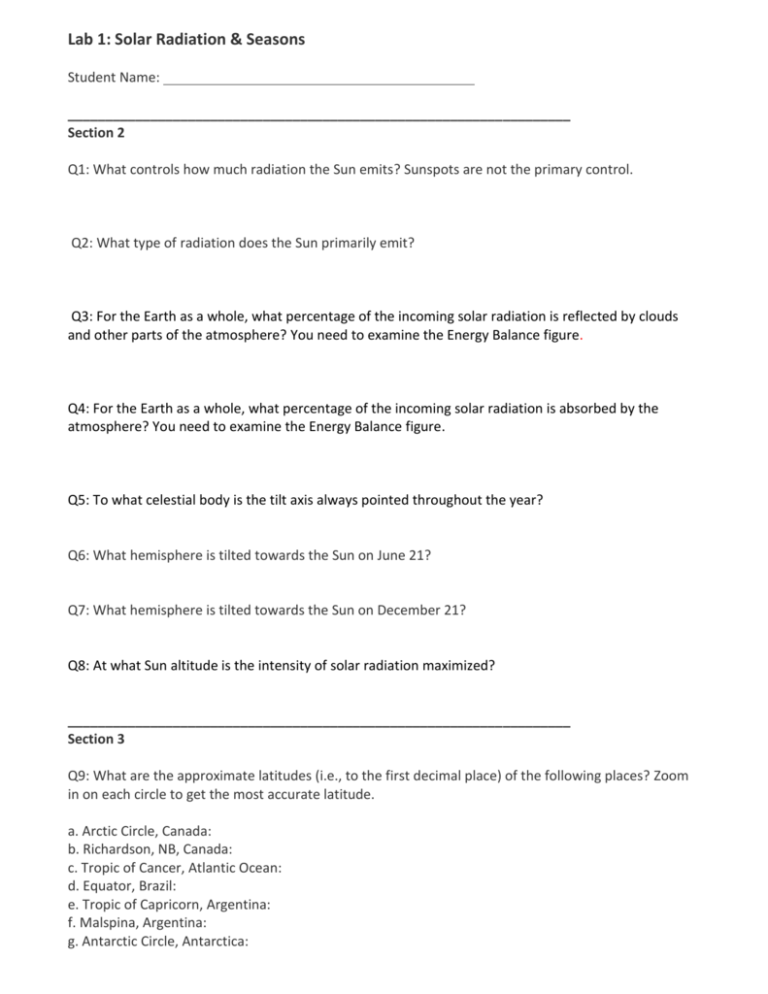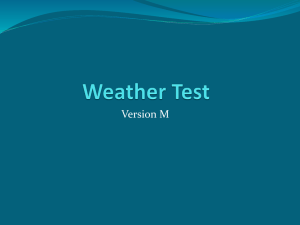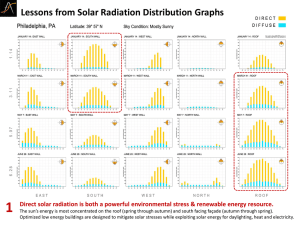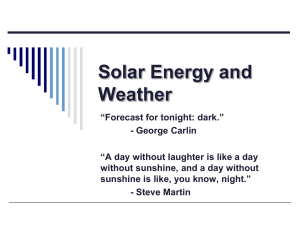Lab 1: Solar Radiation & Seasons
advertisement

Lab 1: Solar Radiation & Seasons Student Name: ___________________________________________________________________ Section 2 Q1: What controls how much radiation the Sun emits? Sunspots are not the primary control. Q2: What type of radiation does the Sun primarily emit? Q3: For the Earth as a whole, what percentage of the incoming solar radiation is reflected by clouds and other parts of the atmosphere? You need to examine the Energy Balance figure. Q4: For the Earth as a whole, what percentage of the incoming solar radiation is absorbed by the atmosphere? You need to examine the Energy Balance figure. Q5: To what celestial body is the tilt axis always pointed throughout the year? Q6: What hemisphere is tilted towards the Sun on June 21? Q7: What hemisphere is tilted towards the Sun on December 21? Q8: At what Sun altitude is the intensity of solar radiation maximized? ___________________________________________________________________ Section 3 Q9: What are the approximate latitudes (i.e., to the first decimal place) of the following places? Zoom in on each circle to get the most accurate latitude. a. Arctic Circle, Canada: b. Richardson, NB, Canada: c. Tropic of Cancer, Atlantic Ocean: d. Equator, Brazil: e. Tropic of Capricorn, Argentina: f. Malspina, Argentina: g. Antarctic Circle, Antarctica: Q10: How do you think the intensity of sunlight and daylight hours will vary among the stations on 20 March 2014 and 22 September 2014? Q11: How do you think the intensity of sunlight and daylight hours will vary among the stations on 21 June 2014? Q12: How do you think the intensity of sunlight and daylight hours will vary among the stations on 21 December 2014? Q13: Where was the noon altitude of the Sun highest and lowest on the equinoxes? Q14: Approximately how many hours of daylight did each of the locations receive on the two equinoxes? Q15: Where was the axis of Earth’s tilted towards on the equinoxes? You answered this in Question 5. Q16: How would you define an equinox? Q17: Where was the noon altitude of the Sun highest and lowest on June 21? Q18: Where was the noon altitude of the Sun highest and lowest on December 21? Q19: What locations had the most and fewest daylight hours on June 21? Q20: What locations had the most and fewest daylight hours on December 21? Q21: Where was the axis of Earth’s tilted towards on the solstices? You answered this in Questions 5 and 15. Q22: How would you define a solstice? ____________________________________________________________________ Section 4 Q23: What are the latitudes and longitudes of Miami, FL USA and Cleveland, OH USA? a. Miami: b. Cleveland: Q24: Which location do you expect to have more solar radiation during the equinoxes and why? Q25: Which location do you expect to have more solar radiation on the June Solstice and why? Q26: Which location do you expect to have more solar radiation on the December Solstice and why? Q27: Why is the surface radiation for each month between 35% to 53% of the radiation at the top of the atmosphere? Q28: Why is there more solar radiation at the top of the atmosphere at Cleveland’s latitude than Miami’s latitude in June and July? Q29: Based on the information above, what aspect of solar radiation causes Cleveland to have more solar radiation than Miami in June and July? Q30: Related to the previous question, what atmospheric factor causes Miami’s surface to receive less solar radiation than Cleveland’s surface in June and July? Q31: What was the atmospheric factor that caused Miami’s surface to receive less radiation than Cleveland’s surface in June and July? ________________________________________________________________________ Section 5 Q32: How did the locations of the warmest areas shift from January to July? Q33: What is the warmest land mass in January and why? Q34: Why does Canada experience much larger differences in temperature from January to July than does Brazil? ________________________________________________________________________ Section 6 Write responses of one to two sentences for each of the following big questions of the lab. Q35: What is the reason for the seasons? Q36: How does Earth’s atmosphere affect solar radiation? Q37: What is the general relationship between latitude, solar radiation, and surface temperature?






